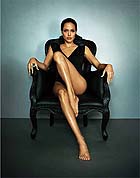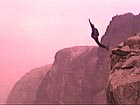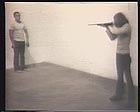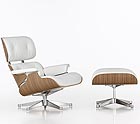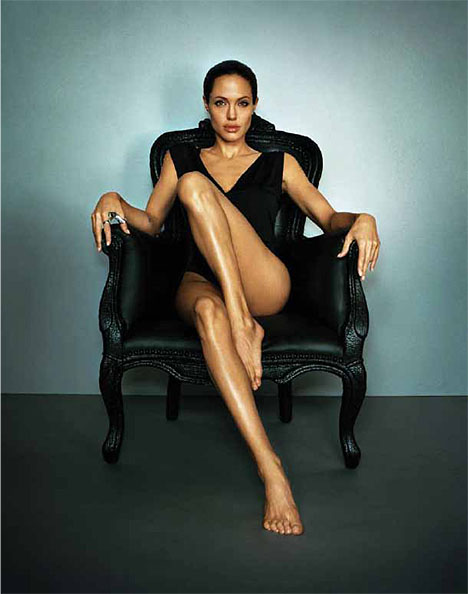
translated and summarized by: Liz Wollner-Grandville,
English summary October 6 - 12 2008
Deichtorhallen: Dreamwomen – Beauty in the 21st century
Slender women younger than thirty
Dreamwomen. The title of the exhibit at Hamburg’s Deichtorhallen is extremely naive. As if one did not know that dreamwomen, that beauty, is something very personal, individual. But that is exactly what the exhibit is trying to show – the individual visions of beauty, as seen by 50 photographers including Peter Lindbergh, Sheila Metzner, Bettina Rheims, and Albert Watson. An individual view, which the curators Nadine Barth and Ingo Taubhorn attempt to describe as “classic, glamorous, personal, lyrical, ironical, headstrong, and visionary”.
In the past, exhibitions at the Deichtorhallen have already tried to combine the world of fashion, glamour, and advertising with the world of art – and it is no different this time: many of the works shown here could be perfect advertisement photos. However, the exhibit and the book want to achieve more than that: they want to present women with personality, dreamwomen that are different.
But only very few of the photographs succeed in presenting the women as being unusually beautiful. And except for Vanessa Redgrave and Louise Bourgeois there are practically no elderly women among the exhibited works. In the eyes of the curators and photographers dreamwomen are mainly slender and younger than thirty. One does, however, wonder what the value of this show is meant to be. After all, the majority of the photographs can be found in nearly every fashion magazine.
The dreamwomen shown in this exhibit are all famous and rather boring. Similar to the statements made by the photographers: “I don’t like boring women. I don’t like beautiful women. I like unusual women, obsessive women, crazy women”. The exhibit was meant to discover “the reality of beauty”, but it got nowhere near its goal.
Deichtorhallen
20095 Hamburg, Deichtorstrasse 1 + 2, until 09. 11. 08
www.deichtorhallen.de
Kunstverein Ludwigshafen: (no) Fear
Not really comprehensible
Fear is everywhere these days. The list of current worldwide fears and threats is long and includes climate change, terrorism, unemployment, economic loss, financial crisis, and hunger. Anxiety is a phenomenon that everybody has experienced and could actually identify him or herself with, if it wouldn’t also lead to envy, greed, and resentment, and taking advantage of the situation.
A group exhibit at the Kunstverein Ludwigshafen is currently focused on the phenomenon of fear. Internationally renowned artists present their view of the different facets of anxiety with the help of all kinds of media and sub topics – ranging from global catastrophes to the dread of illness and death.
This exhibit reflects how people merge real and existing fears with the images shown in the media, respectively how individually experienced angst can be created through globally broadcast media images, thereby transforming fear to a collective sentiment.
Christoph Draeger created puzzles, which - when put together - show photos published in newspapers and magazines depicting the catastrophes induced by hurricanes. Thomas Ruff’s large format photo “ipeg ny15” gives a birds eye view of the smoke clouds created by the deadly attack against the World Trade Centre on 9/11. The blue colour of the sea in the background together with the ascending cloud convey a kind of anaesthetic effect, which benefits from the strong pixel resolution of the image. Adam Thompson’s heavily damaged globe, whose inner hollow was fitted with a deep-black pigment, symbolizes the downfall of the world.
Unfortunately the selection of works shown is much too broad, and the exhibition space is not adequately suitable. The Kunstverein does not offer enough space for intimacy and the possibility to retreat and deal with the visions of fear one is confronted with.
Kunstverein Ludwigshafen
67059 Ludwigshafen, Ludwigshafen, until 02. 11. 2008
www.kunstverein-ludwigshafen.de
Zacheta National Gallery of Art: Revolutions 1968
Miss the revolutionaries!
Currently there are hundreds of events commemorating the Revolutions of 1968. The Zacheta National Gallery in Warsaw of Art chose to present the topic by exhibiting the works of 90 national and international artists. The curators Hanna Wroblewska and Maria Brewinska attempt to portray this period through art from different perspectives - including theatre, film, video, and above all installations. How did the worldwide Revolutions of 1968 influence art? What do the art works shown in Warsaw communicate about the cultural consequences of an initially political revolution?
The curators brought works by Joseph Beuys, the most radical representative of the time, as well as Vito Acconci, John Baldessari, Marcel Broodthaers, On Kawara, Nam June Paik, and Dennis Oppenheim to Warsaw. In 1971 the performance artist Chris Burden presented his film“Shoot”. It shows Burden standing in front of a wall, someone aims a gun at him, and shoots him in the shoulder. Photos and films dealing with terrorism are positioned next to Burden’s work, making it clear that violence triggers violence.
Major emphasis of the exhibit is placed on the media film. Helke Sander and Harun Farocki’s video “Break the power of the manipulators” is a rebellion against media manipulation and was produced in 1967/68 showing members of the student movement campaign in their fight against the German publishing company Springer.
The atmosphere of the time is not mediated by attempting a chronological narration, but rather by the way in which the exhibit is arranged. The works are placed side by side, installations are strung together in individual exhibition halls, and different sounds penetrate from the rooms, reflecting the atmosphere of the time: loud, chaotic – rebellious. Putting things in order was done in retrospect.
The exhibit succeeds in highlighting the cultural changes. Nobody wants a revival of Marxist, Maoist, or Trotskyist ideologies, even if, in today's politic and social environment, some miss the atmosphere, spirit, and the immense will for change of those years.
Zacheta National Gallery of Art
00-916 Warsaw, Pl. Malachoswskeigo 3, until 09. 11. 2008
www.zacheta.art.pl
WAGNER:WERK Museum Postsparkasse: Furniture by Charles and Ray Eames for Vitra
The best for the least
Part of the fascination for Charles and Ray Eames work has a lot to do with their personalities. An advertisement shows Charles grinning mischievously while he is checking details of a cast piece of aluminum, and Ray sitting on a couch designed by her for Billy Wilder, holding her great grandson in her arms, and laughing exuberantly. They always presented their newest furniture designs on US television without any inhibitions whatsoever.
All photos and films showing Charles and Ray Eames transmit their never-ending childish happiness about the richness and diversity of the world. Their attitude resulted in the creation of extremely well thought-out products made with great perfection and astounding timelessness. The pieces of the so-called Aluminum Group created 50 years ago are as fresh today as they were back then. “Take pleasure seriously” was one of the Eames’ mottos and they were convinced that any rigid stylistic determination impedes the search for a simple solution – be it for any task.
Their boundless pleasure for well-designed products is communicated by the PSK exhibit. Vitra International’s product range of Eames designs is jointly presented with numerous prototypes from the Vitra Design Museum. Visitors are invited to sit on the La Fonda Chairs, originally designed in 1961 and now reintroduced on the market. However, Vitra does not respect the Eames motto: “the most of the best to the greatest number of people for the least” - the majority of the Eames furniture, which are doubtlessly among the best the 20th century has to offer, is simply not affordable for members of the normal academic precarity.
WAGNER:WERK Museum Postsparkasse
1018 Vienna, Georg-Coch-Platz 2, until 25. 10. 2008
www.ottowagner.com
Mehr Texte von translated and summarized by: Liz Wollner-Grandville


 Teilen
Teilen

